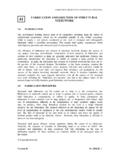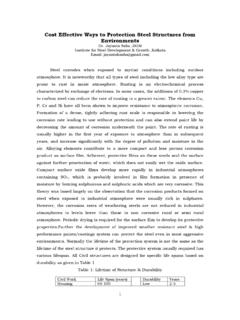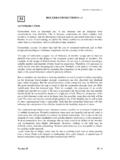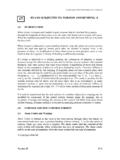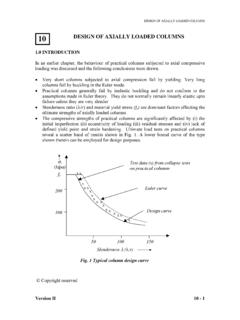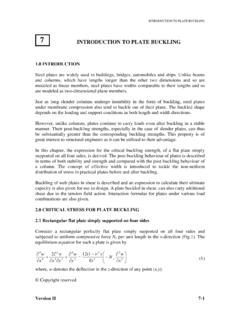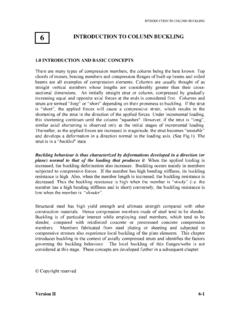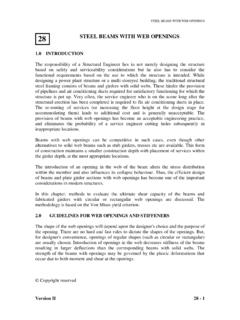Transcription of WELDING OPTIONS IN STEEL CONSTRUCTION
1 WELDING OPTIONS IN STEEL CONSTRUCTION Dr. Jayanta k Saha, Manager Institute for STEEL Development & Growth, Kolkata, India 1. Introduction In India the use of structural STEEL has been growing and it has become an important input material for CONSTRUCTION . Any development of new STEEL application also depends on matching development of the WELDING sector. Thus cost effective WELDING is important in STEEL intensive CONSTRUCTION as reliability; durability and safety of the structure. These are ensured through the strength of the fabricated joints.
2 The standard structural STEEL is having tensile strength of 410-430 MPa (min), and good weldability. The reasons for preferring structural steels are shown in table 1.[1] Table 1: Preferred Properties of structural STEEL Features Reason Light Weight Structural STEEL having high specific strength Durability Reduces overall costs through longer service life Ductility Ability to deform after yielding Shear Strength To prevent instantaneous collapse Weldability Base material besides weld consumables and process. Young s Modulus Resistance to being deformed. 2. Structural STEEL grades used for CONSTRUCTION Plain carbon structural STEEL STEEL commonly known as mild STEEL made as per IS: 2062 Gr.
3 A, B and C is widely used in Indian general CONSTRUCTION sector. These STEEL plates have very good weldability but due to low strength relatively thick sections are required for a load bearing applications. High Strength Low Alloy These steels have been covered under IS 8500 specification. Modern structures need higher strength STEEL in order to reduce weights of structures so as to achieve economy. Hence thinner sections of these grades are used in applications in compare to mild STEEL . Again by ferrite grain refinement with micro-alloying element like Ti, Nb and V (< wt) the strength of STEEL is further enhanced to tensile strength of 400 720 MPa with good weldability and impact toughness at subzero temperatures.
4 [2] Weather Resistance STEEL This STEEL is preferred as CONSTRUCTION material in coastal areas and confirms to IS 11587. These steels may be fabricated in the same manner as ordinary structural steels of the same strength. For all WELDING procedures, appropriate minimum pre-heat temperatures should be used. Proper electrode should be selected in order to remove the possibility of hydrogen induced cracking. Fire Resistant STEEL Normally used in important structural members (column and Beams) of buildings can decrease or eliminate the need for fire insulation coating. With the addition of Cr and Mo yield strength is retained at 600 0 C (Yield strength drops to two third of Room temp value when heated at 300 0 C.)
5 [3] 3. Different forms of STEEL Reinforcing STEEL As per IS 1786 all the bars are weldable at site for all types of joints provided Carbon Equivalent is known (less than is easily weldable). Satisfactory strength is achieved by judicial selection of weld design and WELDING practice. Closed Structures Due to their high torsional rigidity and compressive strength, closed structures behave more efficiently (40% metal saving) than conventional structures. The smooth, uniform profile of these sections facilitates easy fabrication at site. These hollow sections are weldable with standard electrodes without any preheating available. These are made as per IS 4923.
6 Galvanized STEEL It is a generally used in conventional structures and can be welded like uncoated STEEL if the zinc coating is locally removed (at least 25 mm on each side of the joint). Zinc remaining in the weld area as contamination of the weld pool will lead defects like weld embitterment, Porous welds, Spatter.[4] Pre-Painted STEEL Pre-painted sheets are being used in CONSTRUCTION very often for elegant and aesthetic look. All surfaces to be incorporated into the weld itself should be thoroughly cleaned of all coatings or contaminations, and dry immediately prior to WELDING . [4] Stainless STEEL Often combination of stainless STEEL and various structural grades need to be welded.
7 This becomes natural choice in the high corrosivity area or imparting special architectural feature. WELDING of this STEEL with general structural STEEL obviously leads to a mixture of two- weld pool. Hence WELDING should be carried out as per proven WELDING procedure specification. 4. WELDING Technology WELDING is very essential in case of heavily loaded site connection, rigid connection and even in refurbishment job. The overall economy may be achieved thru the selection of right type of weld joint, edge preparation, selection of weld process and selection of filler materials. The most commonly used techniques are for WELDING of structural steelworks [5] a) Shielded Manual Metal Arc WELDING (SMAW) b) Metal Inert Gas WELDING (MIG) c) Submerged Arc WELDING (SAW) d) Stud WELDING Stud WELDING It is a process by which metal fasteners are welded rapidly to the surface of metal components and an electric arc is used to produce necessary heat for fusion weld .
8 The process is actually a combination of heat and pressure. A typical stud welded composite beam with shear connector is shown in fig. 1. [6] Fig 1: Cross Section of Composite Beam with Shear Connectors 5. Cost Effective steps WELDING Consumables The consumables like electrodes normally conform to IS 814/IS 815. WELDING technique is in accordance with IS 816 / 9595. High tensile STEEL electrodes should comply with the requirement of IS offer combination of high strength, adequate ductility and required toughness even at subzero temperatures. The weld metal systems are generally based on alloying combinations of C-Mn-Ni-Mo and perhaps Cr, in terms of microstructure a large difference exist between weld deposits of higher strength and weld deposits of lower strength.
9 The addition of Mo around raises the yield strength by 100 MPa with slight reduction in ductility. Table 2 below shows the strength of weld metals from covered electrodes.[7] Table 2: WELDING of steels in 450 MPa yield strength class Yield Strength Mpa Typical Strength (J at 40 0 C) Strength of weld metals from covered electrodes 450 80 520 150 540 120 610 70 640 125 Shift from process Manual metal arc WELDING process is being gradually replaced by flux cored arc WELDING and is being increasingly used for relatively higher strength structural steels. Apart from the main advantage of higher productivity in WELDING , the process offers WELDING with lower heat input, which favours suitable microstructure formation in weld and HAZ of high strength steels.
10 Various alloy and micro alloy additions are easily possible through flux cored arc WELDING (FCAW).[7] Avoid Risk of Cracking If the carbon Equivalent (CE) of a STEEL exceeds , the WELDING situation changes due to the possibility of cracking in the heat affected zone (HAZ) .And due to increase in volume of martensite, cracks will usually develop the phenomenon called under-bead cracking. Thus proper care will save WELDING rework/rejection. A typical HAZ is shown in fig 2[8] Fig 2: Heat Affected Zone Boundaries The interdependence of factors like CE, cooling rate, heat input, joint type and thickness, hydrogen content and preheat are governing HAZ cracking.
